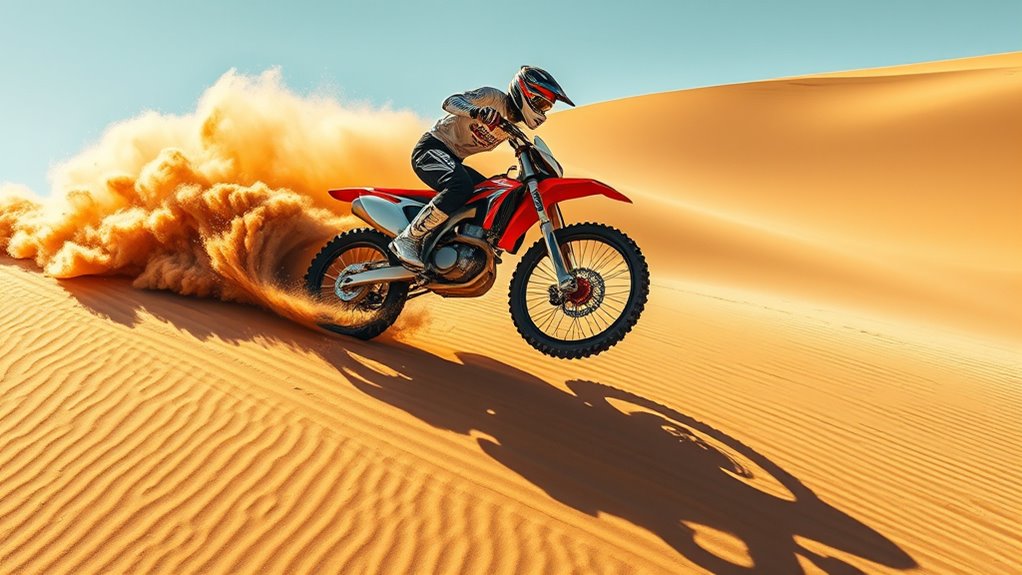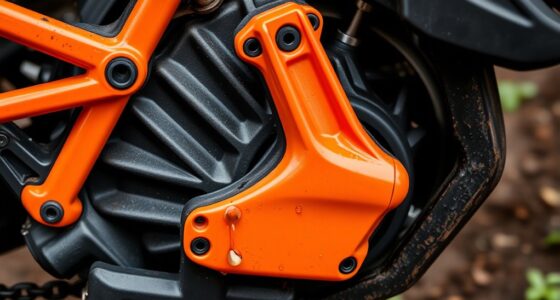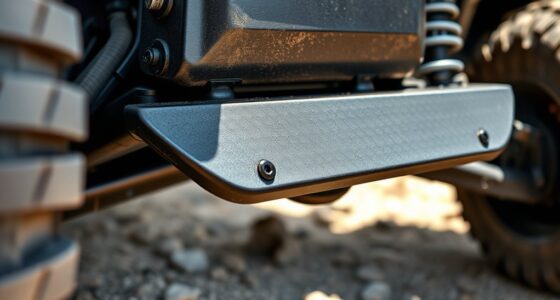When riding in deep sand, focus on maintaining steady momentum and proper body position. Keep your weight centered, leaning slightly back to reduce front wheel load and improve traction. Use smooth throttle inputs and low tire pressures to help your bike float and stay balanced. Stay relaxed and avoid sudden movements, shifting your weight gradually. Mastering these techniques will help you stay composed and avoid getting stuck, and there’s more to discover for confident deep sand riding.
Key Takeaways
- Maintain steady, smooth throttle to preserve momentum and prevent tire dig-in or traction loss.
- Keep body centered and slightly leaned back for better balance and traction in deep sand.
- Lower tire pressure (8-15 psi) to increase contact patch and improve flotation over loose terrain.
- Shift weight gradually and avoid sudden movements to stay balanced and control bike handling.
- Practice controlled riding and obstacle navigation to develop instinctive skills for deep sand conditions.
Understanding the Dynamics of Deep Sand Riding
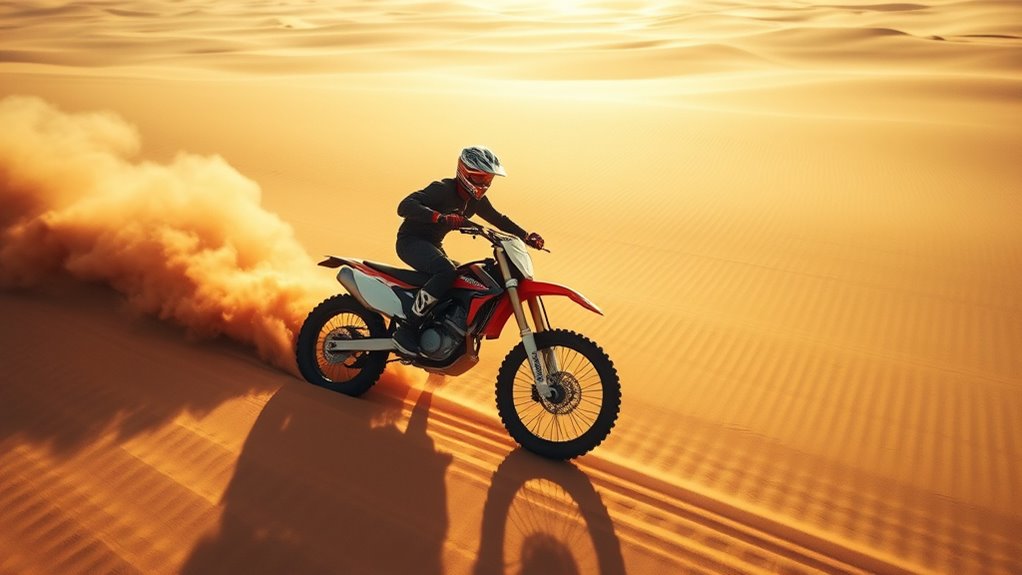
Understanding the dynamics of deep sand riding is essential for maintaining control and momentum. When you ride in deep sand, the terrain shifts beneath you, making traction unpredictable. You’ll find that the bike tends to sink and slide, so staying centered on the bike is vital. You need to anticipate the loss of grip and adjust your body position accordingly, leaning slightly back to keep weight off the front wheel. Keep your throttle steady and smooth, avoiding abrupt inputs that could cause your tires to dig in or lose traction. Recognize that momentum is your best friend here; it helps roll through soft patches and prevents you from getting stuck. Being aware of risk factors such as loose terrain and unstable surfaces can help you prepare and adapt more effectively. By understanding these dynamics, you’ll learn to adapt quickly and ride more confidently through deep sand.
Preparing Your Bike for Sandy Terrain
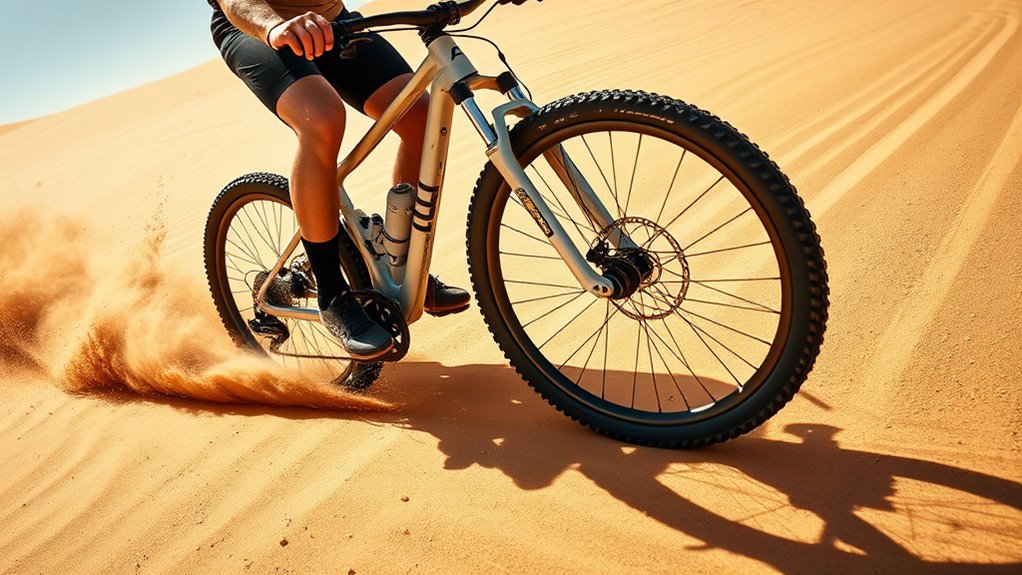
To effectively navigate sandy terrain, you need to prepare your bike with specific adjustments and modifications. Start by loosening your suspension settings slightly to absorb bumps better and prevent bogging down. Lower your tire pressures to increase the contact patch, which improves traction and stability in loose sand. Consider installing wider handlebars for better control and leverage. Remove unnecessary accessories or heavy gear that add weight and can hinder maneuverability. Check your chain and drivetrain, ensuring they’re clean and well-lubricated for smooth power transfer. Adjust your gearing if possible, opting for a lower gear ratio to make pedaling easier. Proper color accuracy ensures that your bike’s display and navigation aids remain clear and visible in varying lighting conditions. Finally, ensure your brakes are responsive, so you can manage your speed effectively without sudden stops that might throw you off balance. Proper preparation sets the foundation for successful deep sand riding.
Choosing the Right Tire Pressure for Deep Sand

To ride effectively in deep sand, you need to find the right tire pressure, typically between 10 and 15 psi. You should adjust your pressure based on how soft or loose the sand feels and your bike’s weight. Finding the most suitable range helps maintain momentum and prevents you from sinking or losing control. Using the correct tire jack size ensures safe and effective adjustments during your ride.
Optimal Pressure Range
Ever wonder how to find the perfect tire pressure for deep sand riding? The key is balancing enough softness to prevent sinking while maintaining control. Generally, you should aim for pressures between 10 to 15 psi, but this can vary based on your weight, bike type, and sand conditions. Lower pressures increase surface contact, helping you float over the sand, but too soft can cause tire burping or loss of control. Higher pressures offer better steering precision but risk digging in or losing traction. Start with around 12 psi, then adjust based on how your bike responds. Remember, the ideal range isn’t fixed—it’s a balance you fine-tune for each ride to maximize momentum and stability. Proper tire pressure is essential for a smooth, efficient deep sand ride. Adjusting tire pressure based on terrain and rider weight helps optimize your ride experience.
Adjust for Conditions
Adjusting your tire pressure based on sand conditions guarantees you get the best performance. When riding in deep sand, softer tires provide more flotation, helping you stay on top rather than sinking. If the sand is loose and dry, lower pressures—about 8-10 psi—are ideal to increase surface area. On firmer or damp sand, you can go slightly higher, around 12-14 psi, for better control. Always monitor how your bike responds and adjust accordingly. Too low, and you risk pinch flats; too high, and you’ll struggle to maintain traction. Remember, conditions can change quickly, so be ready to tweak your pressure as needed. Properly adjusting your tires will improve your momentum, balance and traction, and overall ride quality in challenging deep sand terrain.
Maintaining a Steady and Controlled Throttle

Keeping your throttle steady is key to staying balanced in deep sand. You want to apply smooth power without jerking or sudden acceleration. By maintaining a consistent throttle, you’ll find it easier to control your bike and keep momentum going. Additionally, practicing an even throttle helps develop better control and prevents unnecessary wheel spin.
Smooth Power Application
Maintaining a steady and controlled throttle is essential for steering through deep sand smoothly. Sudden power surges can cause your rear wheel to spin out or dig in, making balance difficult. Instead, apply power gradually, focusing on smooth, consistent acceleration. Use your clutch or throttle modulation to fine-tune your power delivery, avoiding abrupt increases. Keep your wrist relaxed to prevent jerky movements, which can destabilize your bike. As you ride, stay attentive to how the bike responds, adjusting your throttle to maintain momentum without overreacting. Smooth power application helps keep the bike balanced, preventing wheel spin and loss of control. Practicing proper throttle control allows you to develop a feel for the right amount of throttle needed in different sand conditions.
Consistent Throttle Use
Using a consistent throttle is essential for staying balanced when riding through deep sand. Sudden changes in power can cause your bike to lose traction or wobble, making it harder to control. Keep your throttle steady and smooth, applying gentle, even pressure throughout your ride. This helps maintain momentum, preventing the bike from bogging down or kicking up loose sand. Focus on small, controlled adjustments rather than abrupt twists. Staying consistent allows your tires to grip the surface more effectively, giving you better steering and stability. Remember, deep sand demands patience and finesse; a steady throttle helps you stay relaxed and confident. Proper tuning of your bike can also improve handling and stability in challenging terrain. By maintaining a controlled throttle, you preserve your balance and momentum, making deep sand riding safer and more enjoyable.
Avoid Sudden Acceleration
To stay balanced in deep sand, you must avoid sudden acceleration, as quick throttle changes can destabilize your bike. Rapid increases in power can cause your rear wheel to spin out or lose traction, making it harder to control your bike. Instead, focus on maintaining a steady, gentle throttle to keep momentum consistent. Smooth, gradual throttle inputs allow the bike to stay balanced and prevent unexpected shifts that could throw you off course. If you need to accelerate, do so gradually, feeling how the bike responds. Remember, small adjustments are better than sudden surges. Staying composed with your throttle keeps your bike stable, helps you maintain control, and reduces the risk of losing momentum or getting stuck.
Body Positioning and Weight Distribution Techniques

When riding through deep sand, your body position and weight distribution can make the difference between losing momentum and maintaining control. Keep your body centered over the bike, leaning slightly forward to keep traction on the front wheel. Shift your weight back only when climbing steep sections, but avoid behind the seat, which can cause wheel spin. Maintain a relaxed grip on the handlebars to absorb bumps and prevent sudden jerks. Keep your elbows up and knees slightly bent to allow flexibility and better control. Distribute your weight evenly across the bike, avoiding sudden shifts that could destabilize you. Staying balanced and well-positioned helps you respond quickly to changing terrain, conserving momentum and reducing fatigue. Proper body positioning is essential for smooth, confident deep sand riding. Additionally, practicing weight transfer techniques can significantly improve your ability to adapt to the shifting sand.
Using Momentum to Your Advantage

Maintaining and building momentum is essential when riding through deep sand, as it helps you stay stable and avoid getting bogged down. When you keep a steady pace, your bike can glide smoothly over loose terrain, reducing the risk of losing traction or getting stuck. To use momentum effectively:
- Maintain a consistent, moderate speed; don’t accelerate or brake abruptly.
- Use your body weight to stay centered and balanced, helping your bike roll forward smoothly.
- Focus on smooth, controlled throttle inputs to keep momentum steady without causing wheel spin.
- Incorporating suspension upgrades can improve your bike’s handling and stability, making it easier to maintain momentum over challenging terrain.
Navigating Obstacles and Changes in Terrain

As you approach obstacles or sudden changes in terrain, staying alert and adjusting your riding technique is essential. Keep your eyes focused ahead to anticipate upcoming shifts, and stay relaxed to maintain control. When encountering loose sand patches, reduce your speed and shift your weight slightly back to prevent the front wheel from digging in. For obstacles like rocks or roots, stand up slightly and use your legs as shock absorbers, absorbing impacts smoothly. If the terrain suddenly steepens or drops, lean into the change while maintaining steady momentum to keep your balance. Adjust your throttle gradually, avoiding sudden acceleration or deceleration. Being adaptable and responsive helps you navigate obstacles confidently, maintaining momentum and stability through unpredictable terrain.
Recovering From Loss of Balance or Traction

If your balance shifts unexpectedly or traction is lost, quick and controlled reactions can prevent a fall. Stay calm and focus on restoring control. First, gently ease off the throttle to reduce sudden shifts and avoid overcorrecting. Second, shift your weight slightly back and upright to regain balance and traction. Third, look ahead and steer smoothly to align your bike with the terrain, avoiding abrupt movements. Remember, panicking only worsens the situation, so stay relaxed. Practice these steps to develop muscle memory, making recovery instinctive. Maintaining a calm response helps you stay upright and continue riding confidently through challenging sand conditions. Mastering this recovery process ensures you won’t be caught off guard when traction or balance unexpectedly falters.
Practice Drills to Improve Sand Riding Skills
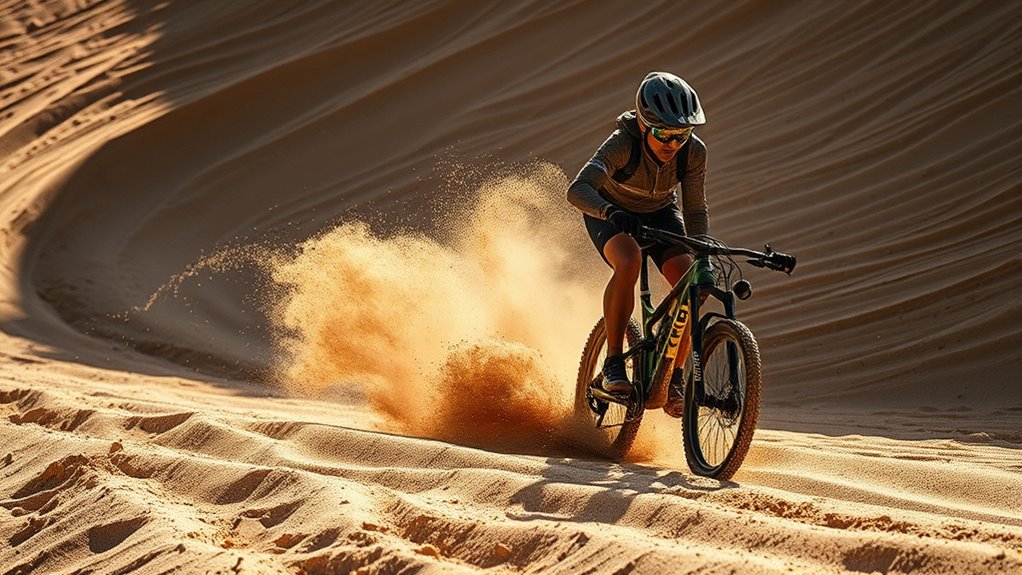
Practicing targeted drills is essential for building the skills needed to handle sand terrain confidently. Start with slow, controlled riding exercises to improve balance and throttle control. Try riding in a straight line at a steady pace, focusing on maintaining momentum without sudden throttle changes. Practice weaving between cones or markers to enhance steering precision and weight shifting. Use standing drills to build core strength and better bike control. Additionally, simulate loss-of-traction scenarios by intentionally applying gentle throttle and then recovering, reinforcing your ability to stay composed. Incorporate these drills regularly, gradually increasing difficulty as your skills improve. Consistent practice helps develop muscle memory, allowing you to react instinctively and ride more smoothly through deep sand.
Frequently Asked Questions
How Do I Identify the Best Line Through Deep Sand?
When choosing the best line through deep sand, you want to look for firm, slightly less loose patches that can support your bike’s weight. Stay relaxed and keep your eyes ahead to spot the flattest, least obstructed route. Aim for a path that avoids sudden turns or obstacles, and prioritize riding on the firmest surface possible. This will help you maintain better control and momentum through the challenging terrain.
What Gear Should I Use for Deep Sand Riding?
Like a skilled dancer adjusting to the rhythm, you should choose a lower gear for deep sand riding. It allows you to maintain control and keep momentum without over-revving the engine. Shift into a gear that’s easy to manage, typically second or third, depending on your bike. This helps you stay balanced, prevents wheel spin, and makes it easier to navigate through the loose terrain smoothly and confidently.
How Can I Prevent My Bike From Getting Stuck?
To prevent your bike from getting stuck, keep your momentum steady and avoid sudden throttle changes. Shift to a lower gear to maintain control and prevent wheel spin. Stay relaxed and balanced, leaning slightly back to distribute weight properly. Use smooth, deliberate movements and avoid aggressive acceleration. By maintaining consistent speed and proper balance, you’ll navigate deep sand more effectively and reduce the chances of getting bogged down.
What Are Common Mistakes Beginners Make in Deep Sand?
Did you know that nearly 60% of beginners struggle most with maintaining momentum in deep sand? When riding in these conditions, you tend to make common mistakes like clutching too hard, which stalls the bike, or leaning back excessively, causing loss of control. Instead, focus on staying relaxed, maintaining steady momentum, and keeping your weight centered. This helps you navigate deep sand more smoothly and prevents getting stuck easily.
How Do Weather Conditions Affect Deep Sand Riding?
Weather conditions greatly impact your deep sand riding. Hot, dry weather makes sand loose and challenging to navigate, requiring you to maintain momentum and balance. Conversely, recent rain can make sand heavier and stickier, making it harder to keep your bike moving smoothly. Wind can blow loose sand into your path, reducing traction. To stay safe, adapt your riding style to these conditions by adjusting speed and posture accordingly.
Conclusion
Mastering deep sand riding takes patience and practice, but with the right techniques, you’ll gain confidence and control. Stay smooth, keep your momentum, and maintain balance—like a boat steady on choppy waters. Remember, “A smooth sea never made a skilled sailor,” so embrace the challenge, stay relaxed, and keep pushing your skills. Before long, you’ll glide through deep sand with ease, turning obstacles into opportunities for adventure.
